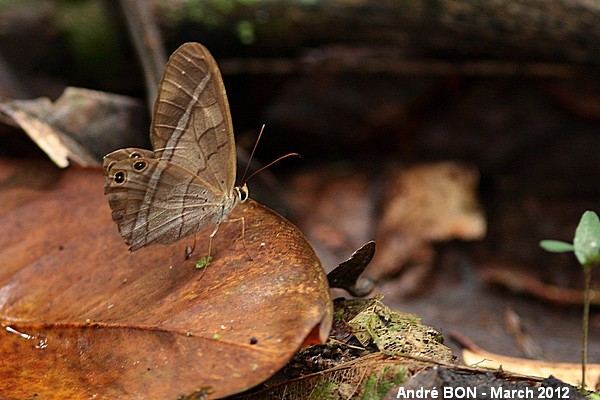
| Astyoche Satyr (Pierella astyoche (Erichson, 1849)) |

|
|
Scientific name: Pierella astyoche (Erichson, 1849) Common name: Astyoche Satyr French name: Piérelle astyoche Order: Lepidoptera Suborder: Rhopalocera Family: Nymphalidae Subfamily: Satyrinae Wingspan: 55 mm. Biotope: Dark areas in the tropical rain forest, on the litter. Geographic area: Brazil, Bolivia, Peru, Ecuador, Guyana, Suriname, French Guiana. Flight time: All year round. Number of generations : Caterpillar: Host plant: Caterpillars of the Pierella genus have been observed on plants of the Heliconia and Calathea genus. |
The Pierella genus includes 11 species which can be recognized by their specific wing shape. The fore wings are elongated with a rounded apex. The hind wings are larger and wider than the fore wings, this is an exception among butterfly species. Pierella astyoche has beige brown wings which are crossed by a paler band finely outlined with dark brown. They are also crossed by a thin dark brown line located between this paler band and the base of the wing. In addition the fore wings show two other small dark brown lines on the half part next to the costal edge. The upper side of the hind wings show a submarginal alignment of 5 ocelli. The two ones which are close to the apex are black, circled with orange yellow and pupiled with white. The three other ones appear like simple white tiny spots. (The Pierella astyoche stollei sub-species, which is found in Brazil, only shows 5 white spots in the submarginal area of the hind wing). You can also distinguish a few dark brown spots close to the base of the wings and two or three white spots in the submarginal area of the fore wings, close to the apex. Pierella astyoche var. albomaculata which bears a large white patch in the anal area of the hind wings is now listed as Pierella lucia. |
| [To know more about the Astyoche Satyr] [Top] |

|
I have shot this picture at Saül, while walking along the Roche Bateau footpath. I was expecting to see three ocelli as small white spots on the underside of the hind wings. I hope that I have not made an error in telling this species apart. |